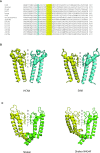When Is a Potassium Channel Not a Potassium Channel?
- PMID: 36325512
- PMCID: PMC9614928
- DOI: 10.1093/function/zqac052
When Is a Potassium Channel Not a Potassium Channel?
Abstract
Ever since they were first observed in Purkinje fibers of the heart, funny channels have had close connections to potassium channels. Indeed, funny channels were initially thought to produce a potassium current in the heart called I K2. However, funny channels are completely unlike potassium channels in ways that make their contributions to the physiology of cells unique. An important difference is the greater ability for sodium to permeate funny channels. Although it does not flow through the funny channel as easily as does potassium, sodium does permeate well enough to allow for depolarization of cells following a strong hyperpolarization. This is critical for the function of funny channels in places like the heart and brain. Computational analyses using recent structures of the funny channels have provided a possible mechanism for their unusual permeation properties.
Keywords: computer simulations; funny channel evolution; funny channel history; funny channel permeation; funny channels; hyperpolarization-activated channels; voltage-gated potassium channels.
© The Author(s) 2022. Published by Oxford University Press on behalf of American Physiological Society.
Figures

Similar articles
-
The funny current: cellular basis for the control of heart rate.Drugs. 2007;67 Suppl 2:15-24. doi: 10.2165/00003495-200767002-00003. Drugs. 2007. PMID: 17999560 Review.
-
Funny channels in the control of cardiac rhythm and mode of action of selective blockers.Pharmacol Res. 2006 May;53(5):399-406. doi: 10.1016/j.phrs.2006.03.006. Epub 2006 Mar 27. Pharmacol Res. 2006. PMID: 16638640 Review.
-
From funny current to HCN channels: 20 years of excitation.News Physiol Sci. 2002 Feb;17:32-7. doi: 10.1152/physiologyonline.2002.17.1.32. News Physiol Sci. 2002. PMID: 11821534 Review.
-
The role of the funny current in pacemaker activity.Circ Res. 2010 Feb 19;106(3):434-46. doi: 10.1161/CIRCRESAHA.109.208041. Circ Res. 2010. PMID: 20167941 Review.
-
Funny currents are becoming serious players in nociceptor's sensitization.J Physiol. 2008 Dec 15;586(24):5841-2. doi: 10.1113/jphysiol.2008.165852. J Physiol. 2008. PMID: 19074817 Free PMC article. No abstract available.
Cited by
-
Alkali metal cations modulate the geometry of different binding sites in HCN4 selectivity filter for permeation or block.J Gen Physiol. 2023 Oct 2;155(10):e202313364. doi: 10.1085/jgp.202313364. Epub 2023 Jul 31. J Gen Physiol. 2023. PMID: 37523352 Free PMC article.
References
-
- Noma A, Irisawa H. Membrane currents in the rabbit sinoatrial node cell as studied by the double microelectrode method. Pflugers Arch. 1976;364(1):45–52. - PubMed
Publication types
MeSH terms
Substances
Grants and funding
LinkOut - more resources
Full Text Sources
